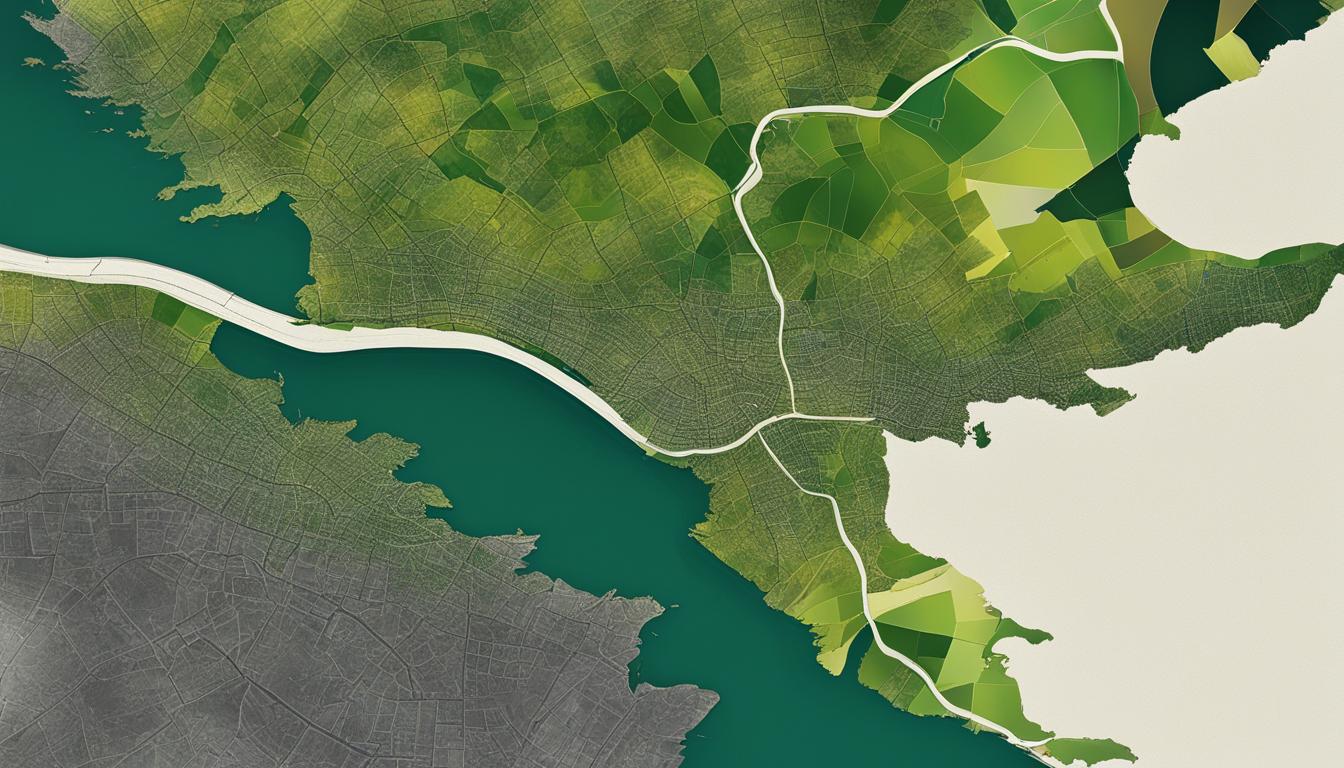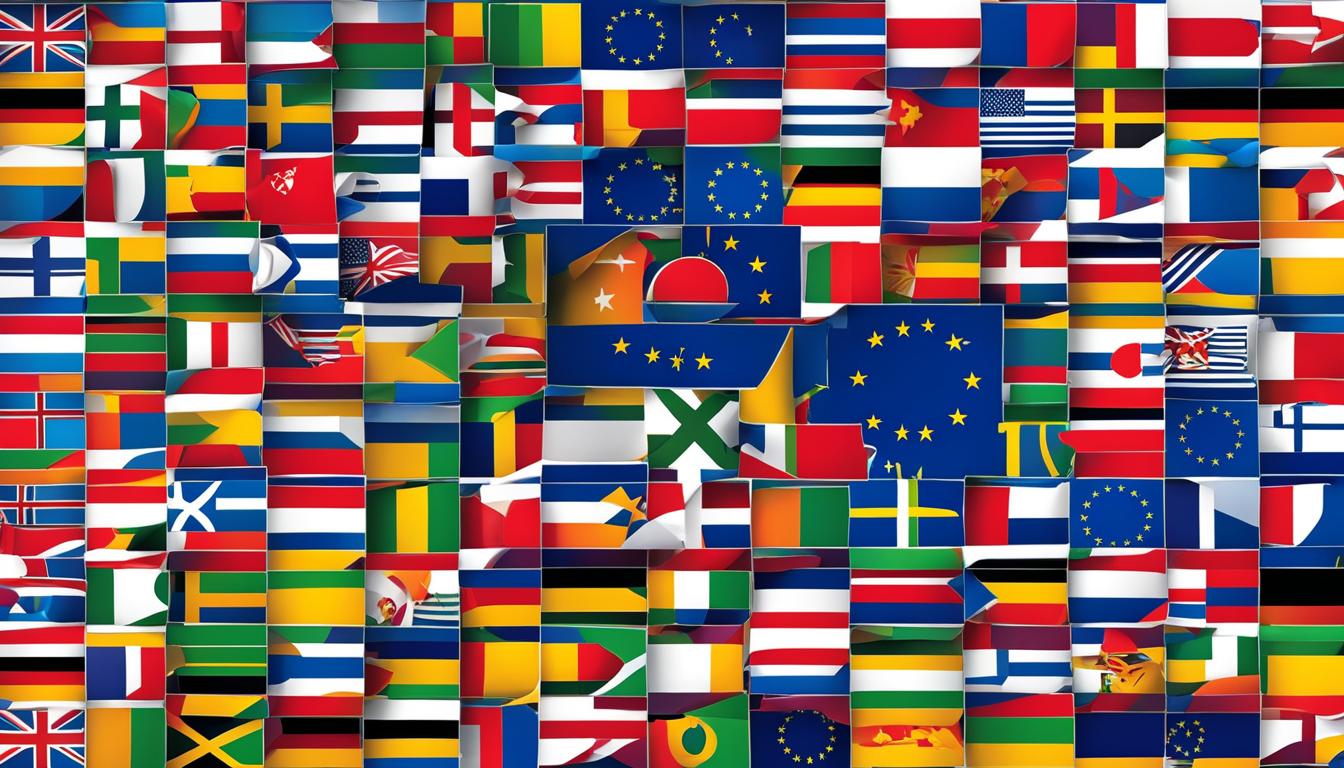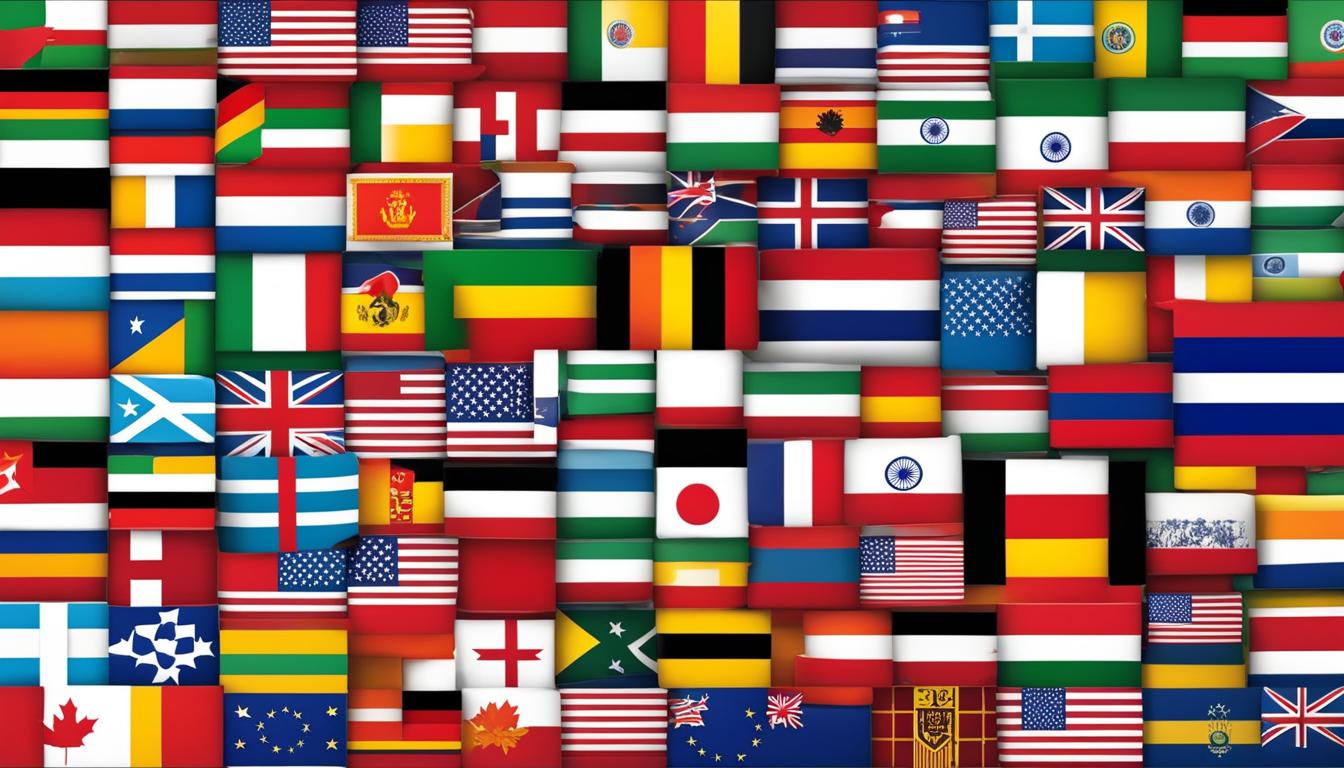The names Great Britain and United Kingdom are often used interchangeably, but they are not synonymous. It is important to understand the geographical and political differences between them.
The British Isles, a group of islands off the northwestern coast of Europe, consist of Great Britain, Ireland, and other smaller islands. Great Britain specifically refers to the island that comprises England, Scotland, and Wales. On the other hand, the United Kingdom includes not only Great Britain but also Northern Ireland.
These geographical differences are integral to understanding the distinctions between the United Kingdom and Great Britain.
Key Takeaways:
- The United Kingdom and Great Britain are not synonymous; they have geographical and political differences.
- The British Isles encompass Great Britain, Ireland, and other smaller islands.
- Great Britain refers to the island comprising England, Scotland, and Wales.
- The United Kingdom includes Great Britain and Northern Ireland.
- Understanding these distinctions helps appreciate the unique combination of political and geographical entities within the UK.
Geographical Differences
When discussing the distinctions between the United Kingdom, Great Britain, and the British Isles, it is essential to consider the geographical differences that define these entities. While Great Britain is often used colloquially to refer to the entire UK, it actually refers specifically to the large island that comprises England, Scotland, and Wales. On the other hand, the British Isles encompass not only Great Britain but also Ireland and other smaller islands.
Great Britain, situated between the North Sea and the English Channel, is the largest island in the British Isles. It boasts diverse landscapes, from rolling hills and picturesque countryside to bustling cities and rugged coastlines. Ireland, a separate island located to the west of Great Britain, possesses its own unique geographical features, including stunning green landscapes, vibrant cities, and breathtaking coastal cliffs.
To give a better understanding of the geographical differences, let’s take a look at a comparative table:
| Geographical Features | Great Britain | Ireland |
|---|---|---|
| Size | Largest island in the British Isles | Second-largest island in the British Isles |
| Location | Between the North Sea and the English Channel | Located to the west of Great Britain |
| Landscapes | Diverse landscapes including hills, countryside, cities, and coastlines | Stunning green landscapes, vibrant cities, and coastal cliffs |
As seen in the table, Great Britain is larger in size and situated between the North Sea and the English Channel. It offers diverse landscapes, from the rolling hills of the countryside to the bustling cities and rugged coastlines. Meanwhile, Ireland boasts its own distinct geographical features, including lush green landscapes, vibrant cities, and breathtaking coastal cliffs.
Political Differences
The United Kingdom, often referred to as the UK, is a political entity that comprises Great Britain and the region known as Northern Ireland. While Great Britain is a political term that includes England, Scotland, and Wales, Northern Ireland remains part of the United Kingdom but has its own unique political situation.
Within the United Kingdom, each constituent country has varying degrees of autonomy in governing certain matters. England, Scotland, and Wales are governed by the UK Parliament in Westminster, while Northern Ireland has a devolved government with certain powers transferred from Westminster. This arrangement reflects the historical and political complexities of the region.
To better understand the political differences within the UK, it is important to recognize the presence of the devolved governments in Scotland, Wales, and Northern Ireland. These governments have the authority to make decisions on a range of policies, including education, healthcare, and transportation, while matters of defense and foreign affairs are handled by the UK government as a whole.
| Constituent Country | Political Situation |
|---|---|
| England | Governed by the UK Parliament in Westminster |
| Scotland | Has a devolved government with powers transferred from Westminster |
| Wales | Has a devolved government with powers transferred from Westminster |
| Northern Ireland | Has a devolved government with powers transferred from Westminster |
Summary
The political differences within the United Kingdom are shaped by the unique histories and identities of its constituent countries. While the UK government in Westminster represents the interests of the entire country, Scotland, Wales, and Northern Ireland have varying levels of self-governance. This complex political landscape reflects the ongoing evolution of the UK as a unified yet diverse nation.
Historical Background
The historical background of the United Kingdom is a complex tapestry that spans centuries and multiple kingdoms. It all began with the Kingdom of England in the 10th century, which later expanded to include Wales under the reign of King Henry VIII. The Kingdom of England and Wales then joined with Scotland in 1707 to form the Kingdom of Great Britain. This union marked an important step in the country’s development and set the stage for further changes in the future.
In 1801, the union expanded once again with the inclusion of Ireland, forming the United Kingdom of Great Britain and Ireland. However, Ireland later seceded from the union in 1922, leading to a change in the country’s name to the United Kingdom of Great Britain and Northern Ireland, as it stands today.
These historical events and political shifts have shaped the identity and structure of the United Kingdom, creating a rich tapestry of cultures, traditions, and governance.
The Evolution of the Kingdoms
Throughout history, the Kingdom of England played a central role in shaping the British Isles. From its humble beginnings as a small Anglo-Saxon kingdom, it grew to become a powerful nation, expanding its influence and territories through conquest and colonization. The Kingdom of England eventually merged with Wales, Scotland, and Ireland to form the United Kingdom we know today.
| Kingdom | Year Established | Significant Events |
|---|---|---|
| Kingdom of England | 10th Century | Expansion, including Wales |
| Kingdom of Great Britain | 1707 | Union with Scotland |
| United Kingdom of Great Britain and Ireland | 1801 | Inclusion of Ireland |
| United Kingdom of Great Britain and Northern Ireland | 1922 | Secession of Ireland |
The evolution of these kingdoms has been marked by political, social, and cultural changes. Each period has left its imprint on the United Kingdom, influencing its governance, traditions, and relationships with other nations.
Countries within the UK
The United Kingdom is made up of four distinct countries: England, Scotland, Wales, and Northern Ireland. Each country within the UK has its own unique characteristics, culture, and regional identity.
England, located in the southeast part of the UK, is the largest and most populous country. It is known for its historic landmarks such as Stonehenge, the Tower of London, and Buckingham Palace. England is also home to the vibrant capital city of London, which is a global hub for finance, culture, and tourism.
Scotland, located in the northern part of the UK, is known for its stunning landscapes, including the Scottish Highlands and Loch Ness. It has a rich history and is famous for its kilts, bagpipes, and Scotch whisky. Scotland has its own devolved parliament and has been campaigning for independence in recent years.
Wales, located in the west part of the UK, is known for its picturesque landscapes, including Snowdonia National Park and the Brecon Beacons. It has a strong cultural identity and is home to the Welsh language. Wales has its own devolved government and a long history of coal mining and industrial heritage.
| Country | Capital | Population | Official Language |
|---|---|---|---|
| England | London | 56 million | English |
| Scotland | Edinburgh | 5.4 million | English, Scottish Gaelic |
| Wales | Cardiff | 3.1 million | English, Welsh |
| Northern Ireland | Belfast | 1.9 million | English, Irish, Ulster Scots |
Northern Ireland, located in the northeast part of the island of Ireland, is the smallest country within the UK. It has a complex history and has experienced political and social tensions, but has made significant progress in recent years. Northern Ireland is known for its beautiful landscapes, iconic Giant’s Causeway, and the Titanic Belfast museum.
Despite being part of the United Kingdom, each country within the UK has its own distinct identity and partially autonomous governance. This diversity adds to the cultural richness and complexity of the UK as a whole.
British Isles and British Territories
The British Isles, encompassing Great Britain and Ireland, are not the only islands associated with the United Kingdom. There are several other islands that are considered British territories. These include the Isle of Man and the Channel Islands, which consist of Jersey, Guernsey, and the Isle of Wight. These territories have their own independent administrations and enjoy varying degrees of autonomy.
In addition to these territories, the United Kingdom also has several British Overseas Territories. These territories, including Bermuda, the Falkland Islands, and Gibraltar, are under British rule but have their own local governments. The British Overseas Territories are scattered across the globe and often have unique cultural and geographical characteristics.
Furthermore, the United Kingdom also has what are known as Crown Dependencies. These are the Isle of Man, Jersey, and Guernsey. The Crown Dependencies are self-governing possessions of the British Crown and are not part of the United Kingdom or the European Union. They have their own legal systems and are responsible for their own domestic affairs.

The British Isles and British Territories: A Comparison
| Category | British Isles | British Overseas Territories | Crown Dependencies |
|---|---|---|---|
| Geographic Location | Located off the northwestern coast of Europe, including Great Britain and Ireland. | Scattered across the globe, with territories in the Atlantic, Caribbean, and South Atlantic Ocean. | Located in the Irish Sea and English Channel, close to the mainland United Kingdom. |
| Autonomy | Part of the United Kingdom, with varying degrees of devolved powers. | Under British rule, but with their own local governments. | Self-governing possessions of the British Crown. |
| Legal System | Follows the legal system of the United Kingdom. | Varies depending on the territory, but often a mix of common law and local legislation. | Has its own legal system and is responsible for its own laws. |
Overall, the British Isles and the various British territories and dependencies reflect the diverse nature of the United Kingdom’s global presence. While the British Isles house the main islands of Great Britain and Ireland, the British territories and dependencies extend the reach of the United Kingdom to regions across the world, each with its own unique characteristics and governance.
Commonwealth Realm
The United Kingdom is a member of the Commonwealth Realm, a group of countries that recognize Queen Elizabeth as their constitutional monarch. These countries share a common allegiance to the British Crown and maintain diplomatic ties and cooperation with each other. The Commonwealth Realm is a unique association that allows member countries to maintain their sovereignty while recognizing the Queen as the symbolic head of state.
Member countries of the Commonwealth Realm include Australia, Canada, New Zealand, and many others. Each country within the realm has its own government and is responsible for making its own domestic and foreign policy decisions. Although the Queen’s role is primarily ceremonial, she plays an important role in fostering unity and goodwill among member countries.
The Commonwealth Realm provides a platform for collaboration and dialogue on issues of common interest. In addition to promoting cultural and economic ties, member countries often participate in events such as the Commonwealth Games, which showcase athletic talent from across the realm. This shared heritage and connection to the British Crown create a sense of camaraderie and mutual respect among member countries.
Table: Member Countries of the Commonwealth Realm
| Country | Capital | Population |
|---|---|---|
| Australia | Canberra | 25.7 million |
| Canada | Ottawa | 37.7 million |
| New Zealand | Wellington | 4.8 million |
| Jamaica | Kingston | 2.9 million |
| … | … | … |
Conclusion
In conclusion, it is crucial to grasp the political and geographical distinctions between the United Kingdom, Great Britain, and the British Isles. The United Kingdom encompasses Great Britain and Northern Ireland and is a distinctive political entity. Great Britain, on the other hand, refers specifically to the island comprising England, Scotland, and Wales.
Expanding beyond Great Britain, the British Isles encompass not only Great Britain and Ireland but also a variety of smaller islands. These historical and political differences have contributed to the unique combination of political and geographical entities found in the United Kingdom, Great Britain, and the British Isles.
Understanding these distinctions is essential for accurate communication and comprehension of the regions and countries within the British Isles. Whether discussing political matters or referring to geographical locations, being well-informed about the United Kingdom, Great Britain, and the British Isles enables us to navigate the nuances of this fascinating region.
FAQ
What is the difference between the United Kingdom and Great Britain?
The United Kingdom is a political entity that includes Great Britain and Northern Ireland. Great Britain refers to the island comprising England, Scotland, and Wales.
What is the British Isles?
The British Isles encompass Great Britain, Ireland, and other smaller islands.
What are the political differences within the United Kingdom?
The United Kingdom consists of England, Scotland, Wales, and Northern Ireland, each with their own distinct identity and varying degrees of autonomy in governing certain matters.
Can you explain the historical background of the United Kingdom?
The Kingdom of England in the 10th century later became the Kingdom of England and Wales, which then joined with Scotland in 1707 to form the Kingdom of Great Britain. Ireland joined in 1801, forming the United Kingdom of Great Britain and Ireland. However, in 1922, Ireland seceded, and the name changed to the United Kingdom of Great Britain and Northern Ireland.
What are the countries within the United Kingdom?
The countries within the United Kingdom are England, Scotland, Wales, and Northern Ireland.
What are the British Isles and British territories?
The British Isles include Great Britain, Ireland, and other smaller islands. The United Kingdom also has British Overseas Territories, such as Bermuda and the Falkland Islands, as well as Crown Dependencies like Jersey, Guernsey, and the Isle of Man.
What is the Commonwealth Realm?
The Commonwealth Realm is a group of countries that accept Queen Elizabeth as their constitutional monarch. Each member country, including the United Kingdom, has its own government and makes its own domestic and foreign policy decisions.
What are the main differences between the United Kingdom, Great Britain, and the British Isles?
The United Kingdom is a political entity that includes Great Britain and Northern Ireland. Great Britain refers specifically to the island comprising England, Scotland, and Wales. The British Isles encompass Great Britain, Ireland, and other smaller islands. These distinctions are a result of historical, geographical, and political factors.



